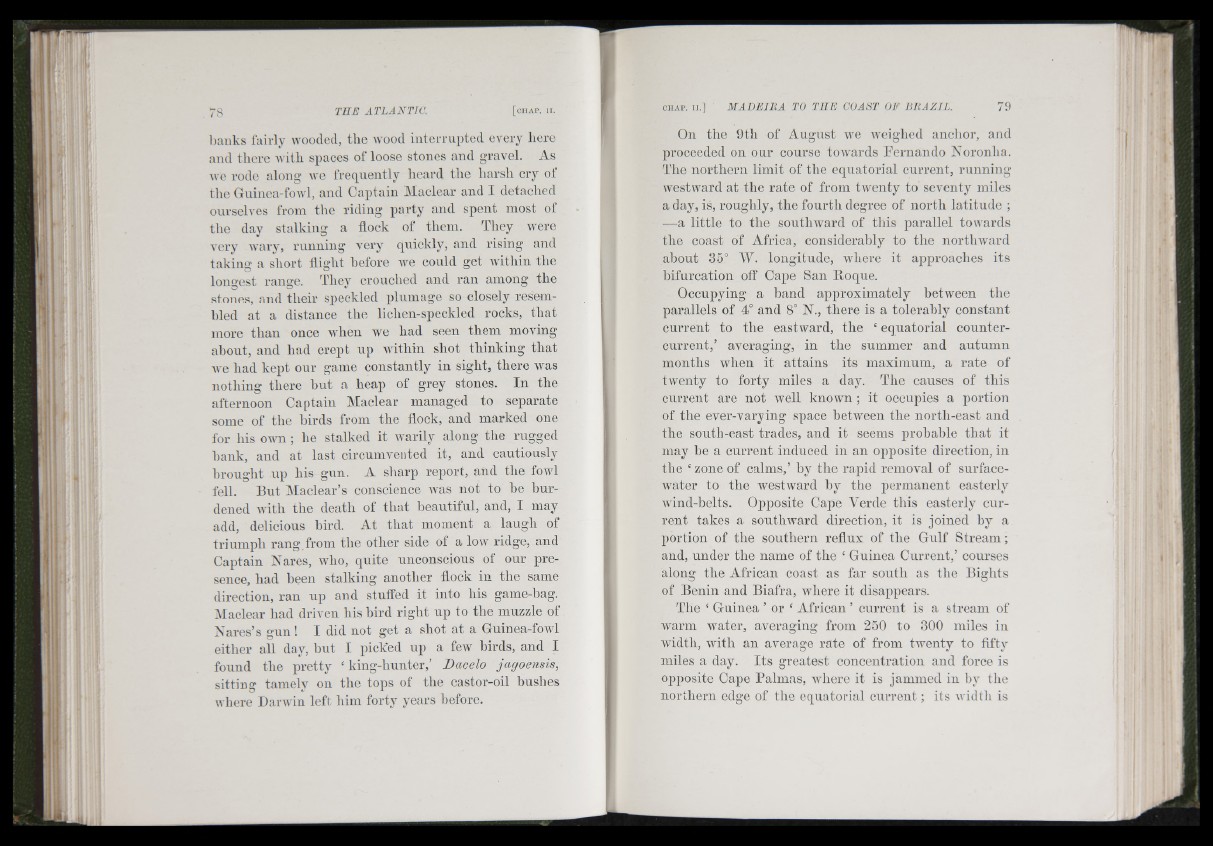
hanks fairly wooded, the wood interrupted every Jiere
and there with spaces of loose stones and gravel. As
Ave rode along we frequently heard the harsh cry of
the Guinea-foAAd, and Captain Maclear and I detached
ourselves from the riding party and spent most ot
the day stalking a flock of them. They AA'ere
very Avary, running very quickly, and rising and
taking a short flight hefore Ave could get Avitliin the
lono-est ransre. Thev crouched and ran among the
stones, and their speckled plumage so closely resem-
hled at a distance the lichen-speckled rocks, th a t
more th an once AA'hen we had seen them moving
ahont, and bad crept up Avithin shot thinking th a t
Ave had kept our game constantly in sight, there Avas
nothing there h u t a heap of grey stones. In the
afternoon Captain Maclear managed to separate
some of the birds from the flock, and marked one
for his ow n ; he stalked it Avarily along the rugged
hank, and at last circumvented it, and cautiously
brought up his gun. A sharp report, and the foAvl
fell. But Maclear’s conscience AA'as not to be b u rdened
Avith the death of th a t heautiful, and, I may
add, delicious bird. At th a t moment a laugh of
triumph rang from the other side of a low ridge, and
Captain Nares, a a T io , quite unconscious of our presence,
had been stalking another flock in the same
direction, ran up and stuffed it into his game-bag.
Maclear had driven his bird rig h t up to the muzzle of
Nares’s gun ! I did not get a shot at a Cuinea-foAAd
either all day, hut I picked up a fcAV birds, and I
found the p retty ‘ king-hunter,’ Dacelo jagoensis,
sitting tamely on the tops of the castor-oil bushes
Avhere DarAvin left liim forty years before.
On the 9th of August Ave Aveiglied anchor, and
proceeded on our course toAA'ards Eernando Noronha.
The northern limit of the equatorial current, running
westvAmrd at the rate of from tAventy to seventy miles
a day, is, roughly, the fourth degree of north latitude ;
—a little to the southward of this parallel towards
the coast of Africa, considerably to the nortliAvard
about 35° W . longitude, where it approaches its
bifurcation off Cape San Roque.
Occupying a band approximately betAveen the
parallels of 4° and 8° N., there is a tolerably constant
current to the eastward, the ‘ equatorial counter-
cu rren t,’ averaging, in the summer and autumn
months wlien it attains its maximum, a rate of
twenty to forty miles a day. The causes of this
current are not Avell known ; it occupies a portion
of the ever-varying space betAveen the north-east and
the south-east trades, and it seems probable th a t it
may he a current induced in an opposite direction, in
the ‘ zone of calms,’ hy the rapid removal of surface-
Avater to the westAvard hy the permanent easterly
wind-belts. Opposite Cape Verde this easterly curren
t takes a southward direction, it is joined hy a
portion of the southern reflux of the Gulf S tre am ;
and, under the name of the ‘ Guinea Current,’ courses
along the African coast as far south as the Bights
of Benin and Biafra, where it disappears.
The ‘ Guinea ’ or ‘ African ’ current is a stream of
AA^arm water, averaging from 250 to 300 miles in
width, Avith an average rate of from tAventy to fifty
miles a day. I ts greatest concentration aud force is
opposite Cape Palmas, AAdiere it is jammed in by the
northern edge of the equatorial current ; its aa idth is
Pm
J